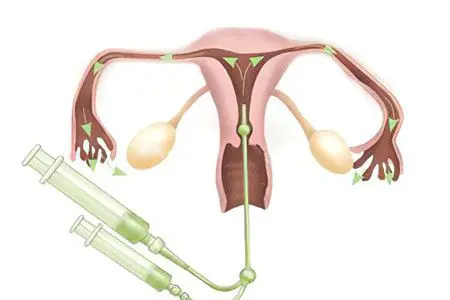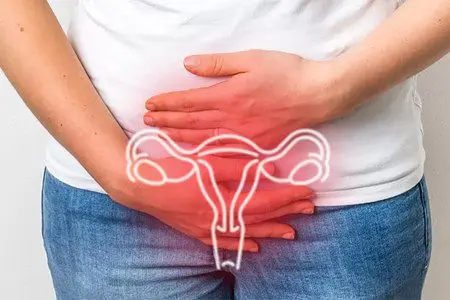Contents

The female reproductive system is complex. When at least one “link” in this chain ceases to function correctly, conception becomes problematic, and sometimes completely impossible.
The fallopian or fallopian tubes play an important role in the process of fertilization. It is through them that the fertilized egg enters the uterine cavity and is introduced into its wall. If she cannot get out of the tube, pregnancy will not occur. Most often this is due to adhesions – thin strands, represented by overgrown connective tissue.
If in past years adhesions were synonymous with the diagnosis of infertility, today doctors have learned how to deal with them. One of the effective ways to remove adhesions is the method of blowing the fallopian tubes. This is not only a therapeutic, but also a diagnostic procedure, which is implemented by forcing air or liquid into the lumen of the fallopian tubes.
Indications for blowing the fallopian tubes

Indication for blowing the fallopian tubes is infertility caused by their obstruction. According to statistics, about 35% of all cases are due to tubal factors.
Reasons that can provoke the formation of adhesions:
Inflammatory process caused by sexually transmitted diseases, including: gonorrhea, chlamydia, mycoplasmosis, syphilis and more.
Endometriosis. This is a hormone-dependent growth of the glandular tissue of the uterus, which extends beyond its limits, including the fallopian tubes.
Mechanical injury to the uterine mucosa and tubes. Abortions, ovarian resection, removal of fibroids, the use of intrauterine contraceptives, IVF attempts, etc. lead to the formation of adhesions.
Hydrosalpinx. This condition is characterized by the accumulation of transudate in the lumen of the fallopian tubes.
Congenital developmental anomalies.
Compression of the fallopian tubes by adhesions that originated in the small pelvis. Most often this occurs against the background of inflammation in the abdominal cavity, which has an acute course: appendicitis, enterocolitis, oophoritis, proctitis, peritonitis.
Pressure on the fallopian tubes by tumors and cysts growing in the pelvic area.
Hormonal imbalance associated with disorders in the functioning of the ovaries or adrenal glands.
Obstruction of the fallopian tubes is dangerous not only by the impossibility of conception, but also by the development of an ectopic pregnancy. With a unilateral adhesive process, the probability of conception is reduced by exactly half. If the process is bilateral, a diagnosis of “tubal infertility” is made.
Symptoms of obstruction of the fallopian tubes

It is infertility that most often becomes the main symptom of obstruction of the fallopian tubes. Spikes grow imperceptibly, without causing any disturbances in the well-being of a woman. The alarming factor should be regular intimacy without protection and the absence of pregnancy throughout the year.
If the obstruction of the fallopian tubes is accompanied by inflammation, then this leads to pain in the lower abdomen. They tend to increase with exertion, with sudden movements, with sports or intimacy. The acute course of the process with suppuration is accompanied by an increase in body temperature, the appearance of purulent discharge. Menstrual bleeding becomes profuse, may occur outside the cycle.
Blowing out the fallopian tubes: the essence of the method
The essence of blowing is that air is introduced into the uterine cavity with the help of special equipment. The procedure is carried out on an outpatient basis or in a hospital. It can pursue two goals: diagnostic and therapeutic.
During the injection of carbon dioxide, the doctor observes the change in pressure on the pressure gauge and the kymogram readings. Based on the data obtained, a conclusion is made about the patency or obstruction of the fallopian tubes, their atony, stenosis or spasm.
Prepare

Before the procedure, a woman must pass the following tests:
A smear for urogenital infections.
PCR test for STDs: chlamydia, mycoplasmosis, ureaplasmosis.
General analysis of blood and urine.
Blood for HIV and hepatitis.
Preparation for blowing the fallopian tubes:
Treatment of diseases of the genitourinary system, if they were detected.
Hygienic toilet of genitals.
Reception of antispasmodics (according to medical indications). The woman receives the drug half an hour before the start of the study.
Emptying the bowels and bladder.
Treatment of the external genital organs with an antiseptic solution.
Stages of blowing the fallopian tubes

During the procedure, the woman is on the gynecological chair. Vaginal speculums are used to expose the cervix. Before the introduction of the device, it is treated with alcohol.
Carbon dioxide is injected into the uterus using a tip. Air intake speed is 25cm3 per minute. From the uterus, it enters the tubes, and then into the abdominal cavity. When the fallopian tubes contract, the pressure changes, the sensor gives signals that are recorded on the recorder (kymogram).
During the procedure, the doctor monitors the well-being of the woman. If she complains of pain, the gas supply is stopped.
After completion of the study, the patient should remain under the supervision of a specialist for 1-2 hours. If the woman feels normal, she is allowed to go home.
Hydrotubation (blowing with liquid)
Instead of gas when blowing the fallopian tubes, a liquid can be used. This procedure is also either diagnostic or therapeutic.
The following compounds can be introduced into the uterine cavity and fallopian tubes:
Saline;
Hormonal preparations;
Proteolytic enzymes;
Antibiotics.
Previously, the drugs are dissolved either in novocaine or in an isotonic solution of sodium hydrochloride. The fluid is supplied using a syringe for intrauterine infusions or using an apparatus designed according to the principle of S. A. Yagunov.
Data interpretation

To assess the patency of the fallopian tubes, the doctor analyzes several parameters at once:
The maximum pressure at which the pipes are passable;
The nature of the kymogram;
The amount of gas that has entered the uterine cavity, tubes and abdominal cavity;
Time of onset of subclavian pain;
The presence of gas in the abdominal cavity;
The appearance of pain in the lower abdomen.
After the procedure, the woman is given one of the following diagnoses:
Pipes passable. The gas pressure will remain within 30-40 mm. rt. Art., during its passage, gurgling and rustling are clearly audible, after 15 minutes there is pain when pressing on the muscles of the supraclavicular region (phrenicus syndrome). Oscillations (oscillations) appear on the kymogram. The amount of injected gas is 100-160 cm3.
Spasm of the fallopian tubes (chronic or short-term). Initially, the gas is injected at a high pressure of 150 mm. rt. st, but with the introduction of an antispasmodic, it decreases. Pain in the supraclavicular region appears after 5-10 minutes, occurs mainly when the patient is transferred to a vertical position. If there are adhesions in the pipes, then phrenicus syndrome occurs no earlier than an hour later. The amount of injected gas is 100-180 cm3.
Impassable pipes. The minimum values of gas pressure are 40-10 mm. rt. Art., and the maximum – 140-180 mm Hg. A trumpet sound is heard, but there is no pain in the supraclavicular region. Due to stretching of the fallopian tubes, a woman complains of discomfort in the lower abdomen. The amount of injected gas is 20 cm3. It is absent in the abdominal cavity.
The treatment of the adhesive process involves an integrated approach, therefore, in addition to blowing out the fallopian tubes, a woman may be recommended to take drugs aimed at resolving adhesions or softening them. For this purpose, enzymes, biogenic stimulants, and placenta-based products are used. Physiotherapeutic procedures help to enhance the therapeutic effect: electrophoresis, electrical stimulation of the appendages and uterus, gynecological massage.
Therapeutic effect

In terms of infertility treatment, blowing out the fallopian tubes gives an effect if the adhesions were small and did not block the entire lumen. It is worth considering that no specialist can give a 100% guarantee of pregnancy. Moreover, a woman is advised to hurry with conception, since destroyed adhesions can form again within a year.
It is believed that the pregnancy that occurred in the same cycle is the successful completion of the procedure. This is due to the fact that the injected gas or medicinal substance removes the derivative that clogged the fallopian tubes. The cleaned fringes lining them from the inside are activated, freely capture and move the egg to the uterus. In addition, under the influence of the supplied composition, it is possible to disconnect thin adhesions that have not yet had time to harden.
If a year after the therapy, there is no effect, then the woman is recommended to refuse to re-purge the fallopian tubes and resort to IVF. This is especially true for patients over 35 years of age.
Противопоказания

Blowing pipes is a complicated procedure, it can only be performed if there are no contraindications. These include:
Any acute and subacute inflammatory processes of the genitourinary system.
The presence of a tumor of the uterus and its appendages.
Severe cardiovascular diseases in the stage of decompensation.
Infectious diseases.
disseminated tuberculosis.
Saktosalpinx.
Colpitis.
Cervical erosion.
The procedure is not carried out against the background of elevated body temperature, even if there are no other signs of the disease.
Complications
With the right selection of patients who have undergone a full examination before blowing, you can not worry about the occurrence of complications. If there are no contraindications, the method is safe.
Complications rarely occur. Isolated cases of embolism are described in the medical literature. Also, when the gas pressure rises to 180 mm. rt. Art. there is a possibility of rupture of the fallopian tubes or uterus. If a woman was poorly examined for infectious diseases, inflammation may spread to the organs of the reproductive system.
Prevention of tubal infertility

To avoid the growth of adhesions in the fallopian tubes, it is necessary to adhere to the following preventive measures:
Prevent unwanted pregnancy in order to prevent the need for an abortion.
Take hormonal drugs and install an intrauterine device only after consulting a doctor.
Refuse promiscuity, use a condom for the purpose of contraception and infection with sexually transmitted diseases.
Regularly visit a gynecologist, treat any inflammation in a timely manner.
Monitor gastrointestinal health.
After a forced surgical intervention, follow all medical recommendations.









